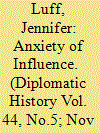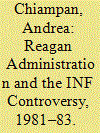|
|
|
Sort Order |
|
|
|
Items / Page
|
|
|
|
|
|
|
| Srl | Item |
| 1 |
ID:
174946


|
|
|
|
|
| Summary/Abstract |
In June 1919, a leaked communiqué printed in New York exposed the “all-pervading system of British intrigue” in the United States during the Great War. The anonymous pamphlet, titled The Re-Conquest of America, reproduced a diplomatic cable that summarized Britain’s covert activities. British intelligence agent William Wiseman and his colleagues had sought to drive Americans into an “Anglo-American alliance” by triggering “anxiety concerning the staunchness of the structure of the nation.” They had begun by “impugning the loyalty to the United States of the Irish, German, and other riff-raff here.” Wiseman’s team had produced a “persecutory mania” by publicizing “German-American and Irish-American plots—discovered and disclosed by our American Secret Service and Military Intelligence Department with carefully calculated timeliness.” Wiseman boasted that “we encouraged the common people to spy upon and to denounce their neighbours; and an orgy of persecution followed.”
|
|
|
|
|
|
|
|
|
|
|
|
|
|
|
|
| 2 |
ID:
174948


|
|
|
|
|
| Summary/Abstract |
In February 1941 Life magazine published “The American Century.” Written by Henry Luce, the media mogul and Life’s owner, the article has become a referential document—the clearest expression perhaps of the United States’ mid-twentieth century claim to global leadership. In the article, Luce invoked a pantheon of well-known people, including Roosevelt, Churchill, Hitler, Lenin, Hoover, and Coolidge. Even the Dalai Lama got a mention, as did Genghis Khan (twice). But only one non-leader figured on the list: Clarence Streit. A New York Times correspondent in Geneva during the 1930s, Streit in 1939 had published Union Now, a book-length proposal for the creation of a federal union of the North Atlantic democracies modeled on the American constitution. For Streit, the “more perfect Union” forged in 1787 in which the thirteen American states had agreed to endow the federal government with exclusive authority over a limited number of areas, should now be applied on a transatlantic scale.
|
|
|
|
|
|
|
|
|
|
|
|
|
|
|
|
| 3 |
ID:
174947


|
|
|
|
|
| Summary/Abstract |
As commander of the sole U.S. vessel charged with enforcing federal gun, alcohol, and hunting laws in the waters of Alaska, Captain Charles A. Abbey was acutely aware that the perennially fog-bound expanse of the eastern Bering Sea rendered his formal authority all but moot. Smugglers and poachers could as easily make landfall on an island or the mainland as slip out to the open sea undetected; the dense marine mist that usually blanketed the islands and seaways provided perfect cover. Even under the bluest of skies, a single police vessel, particularly an aging, overweight steamer like Abbey’s U.S. Revenue Marine Corwin, could never effectively patrol some 600,000 square miles of ocean space.
|
|
|
|
|
|
|
|
|
|
|
|
|
|
|
|
| 4 |
ID:
174944


|
|
|
|
|
| Summary/Abstract |
A riveting narrative depicting the entrapment of an American woman and her daughter in Iran, Not without My Daughter may still be the most well-known depiction of post-revolutionary Iran in the United States. According to the 1987 book memoir and the 1991 movie by the same name, Michigan homemaker Betty Mahmoody agreed to visit Iran in 1984 for a short vacation on the assurances of her doctor husband, a native of Iran whom she had married in the United States. Once in the Islamic Republic, however, her husband forced her and their four-year-old daughter Mahtob to stay in the country. She was allowed to get a divorce and leave; however, Iranian custody laws meant she would have had to leave Mahtob behind. She refused: not without my daughter. After a year and a half of intense surveillance and physical and mental abuse at the hands of Dr. Mahmoody and his close relatives, Betty and Mahtob managed to escape across the mountains into Turkey with the help of smugglers. Finding refuge in the U.S. embassy in Ankara, the two flew back to the United States, where Betty Mahmoody became a household name, giving TV interviews, publishing her best-selling memoir, and offering her expertise to the State Department as a consultant.
|
|
|
|
|
|
|
|
|
|
|
|
|
|
|
|
| 5 |
ID:
174951


|
|
|
|
|
| Summary/Abstract |
In the fall of 1983, the international tension that characterized the Cold War reached new heights. Since the election of President Ronald W. Reagan, Soviet and American leaders had not yet held a summit meeting amid reciprocal accusations. In September, the Soviets shot down a commercial airline flight (KAL 007) that had strayed off course over Soviet airspace killing 269 people, including Congressman Larry McDonald (D-GA).1 In November, the North Atlantic Treaty Organization (NATO) military exercise codenamed “Able Archer” allegedly induced the Soviets to believe that war was imminent. This was perhaps an exaggeration, but in the aftermath of what came to be called the “war scare” many U.S. officials were persuaded that the world had—like in October 1962—come again close to a nuclear confrontation.2 The anti nuclear movement that had gathered unprecedented popular support throughout Western Europe and the United States did not need “Able Archer” to be reminded of the ever-present specter of a nuclear holocaust so graphically depicted in the iconic 1983 film The Day After.
|
|
|
|
|
|
|
|
|
|
|
|
|
|
|
|
| 6 |
ID:
174950


|
|
|
|
|
| Summary/Abstract |
When Aleksei Kosygin visited Turkey in 1975 for the inaugural firing of a massive Soviet-built steelworks, he laid out an ideologically charged vision of development: “unlike the Americans with their Coca-Cola factories, we contribute to industrialization.”1 The Soviet chairman of the council of ministers picked an unusual audience for his disparagement of the United States. Even though Washington had recently imposed an arms embargo in response to Ankara’s intervention on Cyprus, Turkey was still a NATO member. More to the point, Turkey had been a key recipient of U.S. aid since the beginning of the Cold War.2 The Soviet Union could not truly compete with the Western investments that included a Coca-Cola plant which opened in Istanbul in 1964, but Moscow nevertheless committed extensive resources to industrial sites in Anatolia in the 1960s and 1970s. Given that Turkey was closer to the Transatlantic Alliance than the Non-Aligned Movement, the Soviet challenge to U.S.-led modernization in Turkey is an unusual and thus revealing place to find what looks like Cold War competition to develop the Global South.
|
|
|
|
|
|
|
|
|
|
|
|
|
|
|
|
|
|
|
|
|